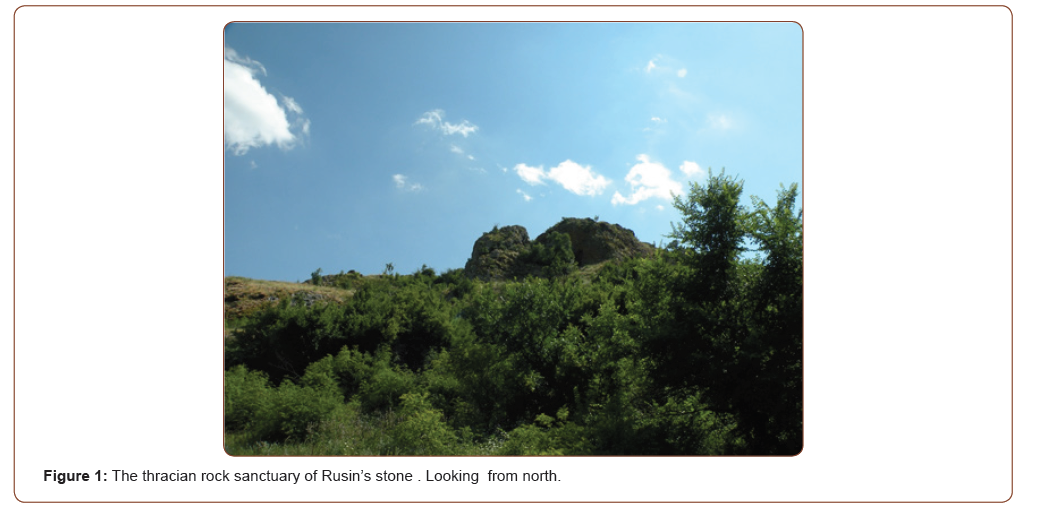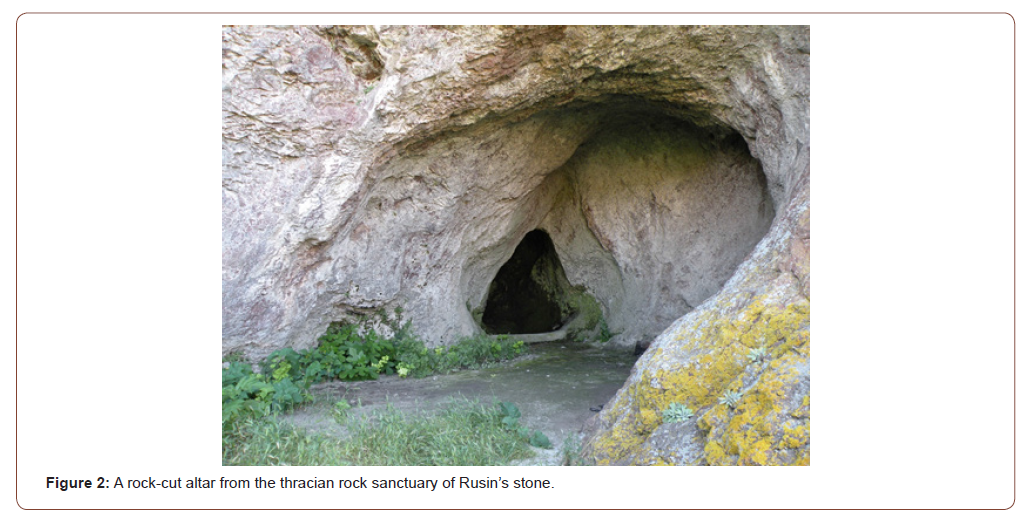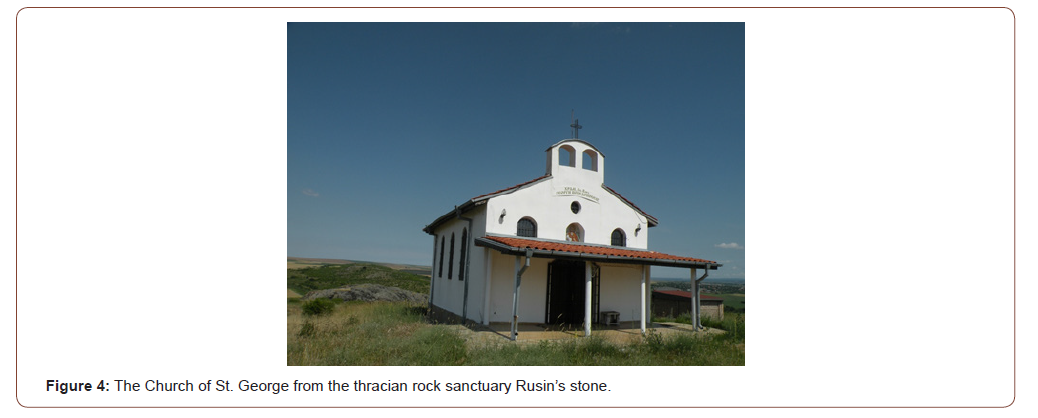 Mini Review
Mini Review
Ancient Thracian Heritage in A Bulgarian Folk Legend
Vassil Markov*
Faculty of Arts, Department of Culture, South-West University “Neofit Rilsk”, Buleria
Vassil Markov, Faculty of Arts, Department of Culture, South-West University “Neofit Rilsk”, Buleria
Received Date: April 01, 2020; Published Date: May 12, 2020
Abstract
The legend belongs to the widespread mythological story “The Dragon Wedding” in Bulgaria. She represent an ancient Thracian heritage in Bulgarian folk culture. The legend find a parallel in the ancient Thracian myth of the north wind Borei. In the form of a dragon, he abducted Princess Oritia from Athens. He made love to her on a cliff in Thrace and made her his wife. The localities associated with this type of Bulgarian folk legends are ancient Thracian rock sanctuaries. This is also the case with the Rusin’s stone near the village of Rusokastro, Burgas region. It is a testament to the remarkable cultural continuity existing in the Bulgarian lands.
Keywords: legend, dragon wedding, mythology, megaliths, sanctuary
Mini Review



One of the many legends devoted to the topic “A Dragon loves a maiden” still existing in the land of Bulgaria is connected to Rusin kamak (Rusin’s stone), which is situated near the village of Rusokastro in the region of Burgas. The locality is the highest and most rocky part of the fortress of Rusokastro and it has the characteristics of a megalithic Thracian sanctuary (Figures 1 & 2). Some round sacrificial altars cut in the stones were found during the archeological research conducted by Drazhya Tsoneva. They mark all the way to the cave known as “The Russin hole”, which most probably is also part of this Thracian rock sanctuary (Figure 3). At the back of the cave there is a sacred spring, which gathers the water that comes down the cave’s walls. This water has healing powers. According to the local folk beliefs it can cure eye diseases and break evil spells cast over pregnant women. In its foot there used to be a Thracian settlement. This was part of the Odryssian kingdom in ancient Thrace. The rock sanctuary Rusin kamak (Rusin’s stone) is part of this settlement complex.
The Bulgarian Folk Legend of The Rusin’s Stone
The legend about this ancient sacred top is also extremely interesting and highly indicative of its connection to the ancient Thracian legacy [1]: Rusin kamak” (Rusin’s stone) is located southwest of the village of Rusokastro. It takes half an hour to get to it from the village. On a very high spot of the eastern side is the church St. George. To the north of the church, at a 10-minute distance, there is a big cliff. On top of it there is a concave place where running water is gathered. This cliff is standing over the river and under it is the cave, or as people call it – Rusen kamakwhere a dragon used to live together with a young maiden he had taken from Rusokastro. Since that time the cliff has been called Rusen kamak / Rusen’s stone/.
The dragon often went to the village but he did not bother the people. Once he went there disguised like a man with a tail. While he was walking around some people dancing horo, a maiden told him: “Old man, pick up your tail.” and everyone started laughing at him. Then the dragon got mad and caused such a whirlwind that no one could see the other people and it lasted for quite a long time. At one moment the dragon flew down and got the maiden that had mocked at him and took her to his hole.
When the young woman gave birth to a child, one night, the dragon took her mother to his cave to help her own daughter take care her own grandchild. She had stayed there for several days without the rest of the family knowing about it. The dragon had taken her all around the numerous rooms in which he lived and then she told people what she had seen. When the child grew up the dragon took the old lady back home, again at night. He gave her an apron with coals in return. The woman, however, threw them away. Only one piece of coal had stayed in the pocket of the apron and when she returned home it became a big golden coin.”
In this story, just like in all famous Bulgarian folk legends, the dragon appears as if he is a gust of whirlwind – a strong circular wind – that takes the maiden away. This fact reminds us of a myth about a Thracian god – the north wind Borey – who was represented in ancient times as a half-human and half-dragon creature. In the legend we are concerned with this image has been preserved in a marvelous way – the dragon is in fact a man with a tail. This is also the next proof in a row for the connection of that kind of “dragon” legends to the myth about the ancient Thracian Borey and Oritya [2,3].
In the old ages this god was given gifts related to some religious practices. Most probably these were the causes for cutting in rocks, gathering water, which had been mentioned in the legend, and which has already been registered in an archeological way. It is especially interesting that there is some king of parallel between this and an ancient Hellenic sacrificial altar in Attica in honour of the winds, described by Pavsanius: “….. When descending from that top”, writes the ancient author, “ there is an altar for the winds, where every year a priest makes sacrifices on one and the same day. He also performs other secret services near black pits in order to tame the wildness of the winds” [4].
The Rock Sanctuary of Rusin’s Stone and the Christian Cult of St. George
The ancient religious practices performed at Rusen kamak / Rusen’s stone/ have been inherited by the Christian cult toward St. George. This is proved by another legend written about Rusin kamak, which is definitely a representation of a Christian version of an ancient Thracian myth that became part of the folklore long time ago. In it the kidnapped maiden is rescued by the Christian saint St. George, who stabbed the dragon with his spear. This event is also the reason why here people had built a Christian temple to honour the saint (Figure 4). In addition, here used to be held the biggest convention in the region of Burgas, where people from all the neighbouring villages gathered till the 50’s of 20th century.

St. Geogre is a saint – a master and a protector of fertility of the fields and that of the cattle. At the same time he is also a dragonfighter [5]. This semantic intensity relates to a great degree to his ancient pagan predecessor – the dragon – the protector and master of the village settlement. The same picture can be seen with a number of analogical sacred Thracian monuments. One of the best examples of a parallel of the researched religious succession in particular is the rock sanctuary called Gergiova skala / George’s cliff/ near the village of Staro Liaski, in the region of Gotse Delchev as well as the megalithic sanctuary St. Gergiova skala / St. George’s cliff/ near the village of Bachevo, in the region of Razlog [6].
The Legend of Rusin’s stone and the Orphic Myth of Incest Marriage
In the legend about Rusen kamak (Rusen’s stone) we can notice the theme of the dragon who lives in an underground castle with a lot of rooms and who owns immense wealth. This topic has been present numerous times in Bulgarian folklore. There is also the repetition of the mythological tale of the birth of a young dragon as a result of the sacred marriage being consummated. What is amazing about it is the fact that the dragon turns to the mother of the maiden to come and help raise the newborn. Despite not being mentioned directly in the text, we know from folklore sources that she was a sorceress and could cast and break bad spells. Perhaps in that aspect she understood the mystery of birth giving. All this knowledge she had learned from the dragon. Here, I should again remind you that according to some, even though very rare, folklore versions she had been loved by the dragon, and thus her daughter had inherited the dragon’s love [7]. This kind of marriage is a sacred one, which resembles too much the Orphic myth of the two incest marriages on Earth – of Zeus – first married to his sister Demetra, and later to his daughter Core / Persephona, as well as the birth of Dionysius – Zagrey [8].
All this makes me believe that, in fact, the ancient myth about Borey and the Athens maiden/princess Oritya, who he kidnaps, is probably just a version of the well-known myth from Orphic theogonies about the love between the dragon Zeus, who is the classical god of the storm, to Demetra and to their daughter – Persephona.
The research on the version of the folk legend “A dragon loves a maiden” is extremely important. It connects the myth directly, especially the consummated sacred marriage between the dragon and the maiden, to the rock that has become sacred too. Probably this version of the Orphic myth about the conceiving and birth of the young Dionysius was most widely spread in Ancient Thrace. There are a lot of rock sanctuaries here that were connected to it and its artefacts have survived to present times in the form of folklore legends [9].
Conclusion
The myth being researched here was absolutely vital in Ancient Thrace. It marked the conceiving and birth of the young god. It marked the new birth and rebirth, which are repeated every year myth-ritually in the frames of the cyclic mythological time, in order to make the traditional team join the sacred event. All this again should ensure the rebirth of nature for a new life in the beginning of every year – in spring. It should ensure the fertility and welfare of the whole traditional team of people. What is highly impressive is that all ancient pagan religious-ritual practices preserved in the folklore are connected particularly to the new birth, fertility and welfare. They were performed in honour of the old pagan master – the dragon. The sanctuaries are also connected to the dragon. They, however, were often later inherited by the Christian saint having the same functions – St. George.
Acknowledgement
None.
Conflict of Interest
No conflict of interest.
References
- Sofia (1983) Bulgarian Folk Poetry and Prose VII: 123-125.
- Apollod 3(15): 2.
- G Batakliev (1985) Ancient mythology. Peter Beron Publishing House, Sofia, pp. 39.
- Paus II, 11: 12.
- E Theodorov (1999) Old-Thracian Heritage in the Bulgarian Folklore. BAS, Sofia, pp. 205-2019
- V Markov (2007) Cultural Heritage and Succession. Heritage of Ancient Pagan Sacred Places in Bulgarian Folc Culture. Neofit Rilski University Press, Blagoevgrad, Bulgaria, pp. 78-109.
- Georgieva (1983) Bulgarian folk mythology.: Science and Art Publishing House, Sofia, pp. 113.
- Al Fol (1991) The Thracian Dionysos. Book One: Zagreus. St. Kliment Ohridski University Press, Sofia, pp.24.
- V Markov (2009) Cultural and historical heritage from the cult of the Sacred Serpent-Dragon in the Lands of the Thracian satri. Neofit Rilski University Press, Blagoevgrad, Bulgeria, pp. 98-165.
-
Vassil Markov. Ancient Thracian Heritage in A Bulgarian Folk Legend. Open Access J Arch & Anthropol. 2(3): 2020. OAJAA. MS.ID.000536.
-
Cyber breaches, Human-Computer Interactions, Human-machine-human, Cyber-security
-

This work is licensed under a Creative Commons Attribution-NonCommercial 4.0 International License.






